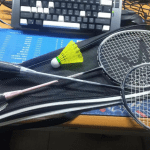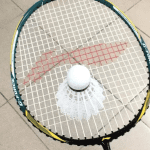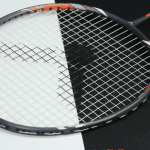
Important parameters of badminton rackets
G:used to indicate the thickness of the handle of the racket, generally 4G, 5G, 4G is suitable for people with large hands.
U: General racket in the description of the information will be used to indicate the weight of U, the specific weight is 3U is 85-89 grams, 2U is 90-94, U is 95-99 grams.
Badminton racket balance point
Why do rackets with the same quality markings feel different in the hand? It is a matter of balance point, if the balance point of a badminton racket is close to the head, it feels heavier on the head, if the balance point of the racket is closer to the handle, it feels lighter on the head. The balance point is measured from the bottom of the racket in centimetres or inches. “According to mechanics, weight is proportional to the feel of the swing, while the balance point is square proportional to the feel of the swing; a racquet with a heavier head hits the ball with more power but with slightly less swinging flexibility due to greater inertia in the head, making it more suitable for offence. A lighter head racket is more flexible but hits the ball with less power and the racket transmits more vibration, making it less suited to players who hit the ball hard and more suited to defensive control players.” , in order to accurately control the balance point, the mass of the handle is generally altered with a view to achieving control of the balance point.
Badminton Racket Extension
The length of a standard racket is 664mm, while the so-called extension rackets are generally 10mm longer than the standard length. The main part of the extension is the shaft, and in some models the head is also slightly longer. Extended length rackets have a higher hitting point, which is helpful to improve the attack.
Racket stiffness: The ball stays on the racket for only four to six thousandths of a second when it is hit. During the swing before hitting the ball and when the racket hits the ball, there is a process of bending and recovery of the racket shaft, and the ball has already flown away from the racket surface before the racket has returned to its original position. With the same player power, the softer the shaft, the easier it bends during the pre-stroke swing, and the greater the bend, which drives the racket head to move at a greater angular velocity, generating a greater hitting power. The stiffer the shaft, the less power can be transmitted to the ball, but the more vibration is transmitted to the ball. For the frame, the stiffer the frame, the less likely it is to deform and twist when it contacts the ball, the more power it can transmit to the ball, and the less vibration it transmits.
Relationship between stiffness and ball control
- Directional control: When the racket hits the ball, the ball can be hit back according to the direction or angle of the shot. The stiffer the shaft and frame, the more stable the directional control and the stiffer the racket, the less torque when the ball is not hit in the sweet spot of the racket face.
- Control of Depth: This refers to the control of the distance (landing point) of the ball being hit back. The control of depth is related to the player’s own strength. The softer the racket, the better the control of depth for the same amount of strength.
Badminton Racket TI Series
TI is the abbreviation of TITIAN, which means titanium; the most important feature of this series is that the head of the racket is divided into two semicircles, the upper and lower, and the two semicircles are connected by titanium alloy composite material, in order to achieve the hardness of the head of the racket is increased, so that the ability to control the ball is greatly improved.
Badminton racket shape
There are two main shapes, oval and square, the oval shape has a small area but less air resistance, while the square shape has a large hitting area but more air resistance. Of course, there are also other shapes based on this, and we will not discuss them one by one.
badminton racket weight
Tolerance of the racket head












